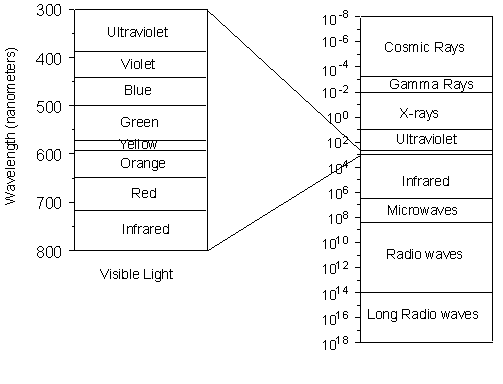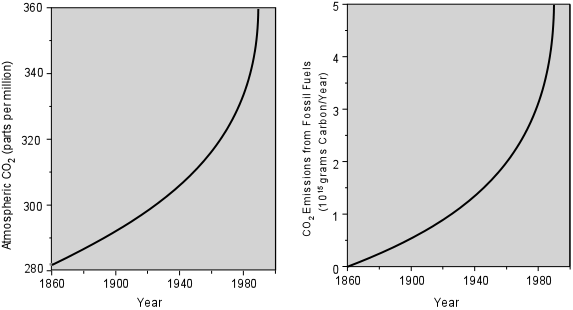
| EENS 1110 | Physical Geology |
| Tulane University | Prof. Stephen A. Nelson |
Our Changing Planet |
|
|
|
We started this course by stating that the Earth is a complex system. Changes that take place in one part of the system have effects on other parts. The tectonic system is driven by the heat in the Earth. This drives the rock cycle, which is also affected by the atmosphere and biosphere. The atmosphere is in chemical equilibrium with the oceans and exchanges matter with the biosphere. All process act on a variety of time scales from hundreds of millions of years to microseconds. We as human beings are only now realizing that, as part of the biosphere, we have an effect on the Earth. What the effect is, we are only now beginning to understand. Here we try to put this in perspective. One of the reasons life exists on Earth is that the surface has a controlled temperature in the range between the freezing and boiling points of water. The Earth is the only planet in the solar system where this is true. Part of the reason for this results from the distance from the Sun. But, the reason that temperature remains fixed is controlled by the atmosphere. Solar Radiation and the Atmosphere Radiation reaching the Earth from the Sun is electromagnetic radiation. Electromagnetic radiation can be divided into different regions depending on wavelength. Note that visible light is the part of the electromagnetic spectrum to which human eyes are sensitive. The lowest wavelengths of the spectrum have the highest energy. Infrared & microwaves carry considerable amounts of heat energy. |
 |
Earth receives all wavelengths of solar radiation. But certain gases and other contaminants in the atmosphere have different effects on different wavelengths of radiation. Dry air is composed of about 78% Nitrogen, 21% oxygen, and 1% Argon. It also contains water, 4% at saturation, but saturation depends on temperature. In addition trace gases have an effect. Among the trace gases are:
|
| Ozone (O3)
Ozone is produced in the upper atmosphere (30 - 35 km above surface) by incoming ultraviolet radiation. Ultraviolet radiation causes O2 to go to O + O. Some of the O then recombines with O2 to make O3. This ozone then absorbs more ultraviolet radiation and breaks down to O2 + O. This O can then can recombine with O2 to make more Ozone. The process is self regulating and results in less ultraviolet radiation reaching the Earth's surface. |

|
|
|
Carbon Dioxide in the Atmosphere
The Carbon Cycle We must look at how carbon moves through the environment. Carbon is stored in four main reservoirs.
|
| Cycling between the atmosphere and the biosphere occurs
about every 4.5 years. Cycling between the other reservoirs occurs on an average
of millions of years.
For example, carbon stored in the Earth in sedimentary rocks or as fossil fuels only re-enters the atmosphere naturally when weathering and erosion expose these materials to the Earth's surface or volcanoes erupt. When humans extract and burn fossil fuels the process occurs much more rapidly than it would occur by natural processes. With an increased rate of cycling between the Earth and the atmosphere, extraction from the atmosphere by increased interaction with the oceans, or by increased extraction by organisms must occur to balance the input. If this does not occur, it may result in increasing concentrations of CO2 in the atmosphere and result in global warming. |
Volcanoes produce several things that result in changing atmosphere and atmospheric temperatures.
The Mt. Pinatubo eruption in 1991 and El Chichón eruption in 1981 released large quantities of dust and sulfur gases - resulted in short term cooling of atmosphere. Volcanism in the middle Cretaceous produced large quantities of basalt on the seafloor and released large amounts of CO2. The middle Cretaceous was much warmer than present, resulting in much higher sea level. |
Paleoclimatology
Before we can assess the human impact on global climates, we need to first look at how climates have varied in the past. The study of such past climate change is called paleoclimatology. Such study involves the study of earth history using stratigraphic methods to look for indicators of ancient climates. It also involves the study of how sea level has changed through time, again using clues left in the rock record and how ocean temperatures have changed in the past using stable isotope ratios observed in fossils. Because air can get trapped in glacial ice, drilling through the ice to find air bubbles trapped in the ice can be used to obtain samples of ancient atmospheres.
Combining this with radiometric age dates allows us to determine how concentration of CO2 and methane in the atmosphere has changed over time, as well as how dust concentrations in the atmosphere have varied. Paleoclimatology also involves using the data to construct computer models in attempt to understand the causes of past climate change and project how climates might change in the future. From our study of glaciations we know that climate can change as result of natural processes, both becoming warmer and colder than present. Although these climatic fluctuations appear to be caused by Malinkovich cycles, it is interesting to note that during glaciations in the past the concentrations of greenhouse gasses in the atmosphere were lower, atmospheric dust was higher, and the Earth's albedo was higher, all of these factors could have contributed to cooler climates. Similarly, during past interglacial episodes, the atmosphere contained less dust, higher concentrations of greenhouse gases, and the Earth had a lower albedo, all of which contribute to warmer climates. The questions that remain to be answered are:
Geologists have been able to reconstruct CO2 concentrations in the atmosphere for the past 100 million years, and average atmospheric temperature based on a wide variety of geologic and geochemical evidence. From this reconstruction, it appears that temperature was much higher than present during the Mid-Cretaceous, during the Eocene, and during the Pliocene. We will next look at what might have caused these periods of global warming. |
| Mid-Cretaceous
During this period we note the following observations:
|
 |
This example serves to show how events deep within the Earth, (events taking place at the core - mantle boundary) could have a drastic effect on conditions at the Earth's surface. |
| Eocene Global Warming
During Eocene we note the following:
The increased CO2 concentrations have been attributed to a large scale metamorphic event that occurred as a result of the continent-continent collision that began to uplift the Himalayas, and other metamorphic events that occurred in the Mediterranean region and the Circum-Pacific region during the Eocene. Such metamorphic events, particularly in the upper parts of the metamorphic areas where greenschist metamorphism would occur, would release large amounts of CO2 into the atmosphere. This example shows how the rock cycle itself, aided by tectonic processes could affect atmospheric conditions. |
Humans and Climate Change The CO2 concentration in the atmosphere has been increasing since the mid 1800s. The increase correlates well with burning of fossil fuels. Thus, humans appear to have an effect. |
 |
Methane concentration in the atmosphere has also been increasing. Naturally this occurs due to decay of organic matter, the digestive processes of organisms, and leaks from petroleum reservoirs. Humans have contributed through domestication of animals, increased production of rice, and leaks from gas pipelines and gasoline. |
|
Global Warming
Average global temperatures vary with time as a result of many processes interacting with each other. These interactions and the resulting variation in temperature can occur on a variety of time scales ranging from yearly cycles to those with times measured in millions of years. Such variation in global temperatures is difficult to understand because of the complexity of the interactions and because accurate records of global temperature do not go back more than 100 years. But, even if we look at the record for the past 100 years, we see that overall, there is an increase in average global temperatures, with minor setbacks that may have been controlled by random events such as volcanic eruptions or El Niņo events (See figure 23.27 in your text). Records for the past 100 years indicate that average global temperatures have increased by about 0.7oC. While this may not seem like much, the difference in global temperature between the coldest period of the last glaciation and the present was only about 5oC. |
|
In order to predict future temperature changes we first need to understand what has caused past temperature changes. Computer models, called Global Circulation Models have been constructed to attempt this. Although there is still some uncertainty, most of these models agree that if the greenhouse gases continue to accumulate in the atmosphere until they have doubled over their pre-1860 values, the average global temperature increase will be between 1 and 5oC by the year 2050. This is not a uniform temperature increase. Most models show that the effect will be greatest at high latitudes (near the poles) where yearly temperatures could be as much as 16oC warmer than present. |
Effects of Global Warming
|
|
| Hopefully this will give you an idea about how human beings can effect the
way the Earth works, and also give you an idea about the complexity of the interactions
between various parts of the Earth and processes that occur throughout the Earth.
Unfortunately, the complexity of the processes are not completely understood. This has major political implications. For example, scientists are uncertain about the reliability of models that attempt to predict future conditions. This uncertainty is taken by some political factions as a denial that an event like global warming will take place.
Most scientists, however, agree that global warming is taking place and that human input of carbon dioxide into the atmosphere is most likely responsible. Politicians want, or expect you to want, exact answers with no uncertainty. That is not the way science works. The real question, however, is whether or not we should be preparing for such events to avoid disaster if the warming trend continues, or, since we can't be absolutely certain, just wait until the disaster has occurred and we can do nothing about it. |
Examples of questions on this material that could be asked on an exam.
|